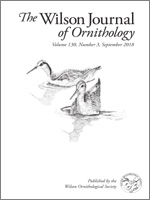With the exception of sites along coastal Texas, southeast Oklahoma, and coastal South Carolina, the winter distribution and abundance of Yellow Rail (Coturnicops noveboracensis) is poorly understood. Along the northern Gulf Coast region, winter occurrence is suspected based on a scattered collection of museum specimens and anecdotal observations, although the extent of this species' distribution is uncertain. To address this lack of information, we performed systematic rope-dragging surveys at night targeting Yellow Rails at 17 wet pine savanna patches (size range 1.9–83.3 ha) and one high salt marsh site (13.1 ha) located along coastal Alabama and Mississippi during the winter/spring seasons (Dec–Apr) of 2011–2013. For all sites combined, we flushed 123 Yellow Rails over 117.4 survey hours, yielding 1.0 rail/h. Of these, we captured and banded 61 rails (50%). The sex ratio for birds, discernable through morphometric measurements (n = 40 ind.), was ∼1:1 male-to-female. The relative abundance of Yellow Rails increased in relation to the size of the area surveyed and was higher at sites burned within 3 years. Across sites, each additional hour of survey effort increased the number of birds detected by 0.66 rails/h. Our findings indicate Yellow Rails overwinter in wet pine savanna habitats along the northern Gulf Coast region, providing additional information supporting the ecological importance of these dynamic coastal communities for this and other imperiled grassland obligate species.
How to translate text using browser tools
1 September 2018
Winter use of wet pine savannas by Yellow Rail (Coturnicops noveboracensis) along coastal Alabama and Mississippi
Eric C. Soehren,
Scott G. Hereford,
Kelly M. Morris,
John A. Trent,
Jacob Walker,
Mark S. Woodrey,
Scott A. Rush
ACCESS THE FULL ARTICLE
Alabama
dragline
fire
high salt marsh
Mississippi
relative abundance
wet pine savanna





